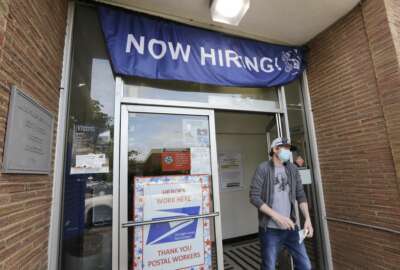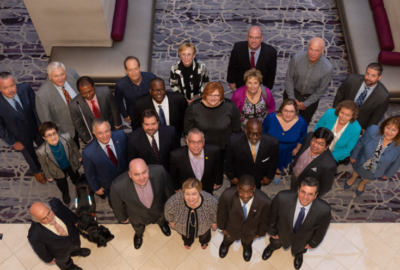A hopeful call for more volunteerism
Each year tens of thousands of Americans volunteer to help communities through the Corporation for National and Community Service, the CNCS.
Best listening experience is on Chrome, Firefox or Safari. Subscribe to Federal Drive’s daily audio interviews on Apple Podcasts or PodcastOne.
Each year tens of thousands of Americans volunteer to help communities through the Corporation for National and Community Service, the CNCS. The whole idea got a boost recently with the release to Congress a comprehensive plan from the National Commission on Military, National and Public Service — and by the pandemic. For the recent trends in community service and where it needs to go, the Federal Drive with Tom Temin turned to the CNCS chief executive, Barbara Stewart.
Interview transcript:
Tom Temin: Mrs. Stewart, good to have you on.
Barbara Stewart: Good be with you Tom.
Tom Temin
And I guess at least from my point of view, the CNCS is probably one of the more fun and productive agencies that a lot of people don’t know about. So review for us what you do and give us some of those statistics of how many people volunteer through it every year.Barbara Stewart: Sure. I share your view that it’s one of the most interesting little federal agencies. We are the federal agency for national service and volunteering. The Corporation for National and Community Service has a goal of making service the cornerstone of our American culture. So we run programs that your listeners are likely familiar with, Americorps, Senior Corps, and we also promote two days of national service, one on the Martin Luther King holiday, and the second on September 11. We have a huge network of alumni as well as currently serving members. You may be surprised to hear that there are more than 80,000 Americans serving in our AmeriCorps program on any given year, and more than 200,000 seniors serving in our Senior Corps program. And we now have a network of more than 1.1 million alumni.
Tom Temin: So that’s a pretty good number and a pretty good network — and what are the types of things that typically people do?
Barbara Stewart: So the types of service varies tremendously, and is reflective of the needs of the communities in which they’re serving. So to give you some examples of service that has been particularly in demand because of the effects of COVID. More than half of our Senior Corps and AmeriCorps members serve in schools, and they serve as tutors or mentors or assistance helping with reading and performance in schools throughout the country. We have AmeriCorps and Senior Corps members serving in all 50 states and the District of Columbia and the territories. Other types of service that AmeriCorps and Senior Corps members provide include working with elderly seniors to provide them companionship and assistance. We also do a lot of work in the conservation space, working in national parks and other outdoor areas. AmeriCorps and Senior Corps members are often deployed to address natural disasters, which could be hurricanes or tornadoes or forest fires. We’re seeing a real uptick in activity in the food insecurity space, AmeriCorps and Senior Corps members serving at food banks or helping to distribute food. And then we’re also active in the education space, and also working with veterans and military families. So there are literally service opportunities all over the country in a real myriad of different organizations. We currently partner with more than 2,000 nonprofit and community organizations throughout the country.
Tom Temin: Wow. And give us a sense of the agency itself. How big is it in terms of staff? And are you funded by appropriations or some other means?
Barbara Stewart: So by federal standards were relatively small. We have just around 600 federal employees, and we are funded through appropriations. We have an annual appropriation.
Tom Temin: When you mention emergency response and conservation, very often you are having people involved with programs where there are many other federal agencies involved in other professional workforces. How do you interact with say a FEMA or a geological survey or a Fish and Wildlife Service. I’m making these up, Agriculture Department, such that you can deploy people where they need them and whether they can be effective without interfering with what the agency is doing?
Barbara Stewart: Great question Tom. We do partner with a number of other federal agencies. One of our biggest partnerships is with FEMA. We actually have FEMA Corps, which is an AmeriCorps program composed of young people who are interested in long term careers in FEMA, and in service around natural disasters. So we work closely with FEMA on FEMA Corps, and a lot of our programs coordinate with FEMA around the volunteer component of work during and immediately after a disaster. We also partner with the Park Service, we partner with some agencies that might surprise you. We partner with the Department of Justice on elder justice issues. We partner with HUD specifically on working with them to have some of our AmeriCorps members working in their envision centers. So we have a number of partnerships with other federal agencies.
Tom Temin: I mentioned this in the opening that the National Commission on Military, national and Public Service, a separate kind of congressional gambit, did turn in a major report on many aspects of public service. Has that given a boost to the activities that you’re doing, or can you see that yet?
Barbara Stewart: We can see it. We work closely with the National Commission and really loved the work that they did on a number of areas. They focus, as you mentioned, on government service, military service, but also on national service. And they came up with a number of recommendations that we embraced and think create great opportunity. One that I might point out is a suggestion that we work more closely with our colleagues in the military on recruitment, and identifying opportunities, both post and pre military and national service. So that is something that we are looking forward to moving ahead on. They also recommended that our agency do a better job of communicating about service opportunities, really do a communications effort around the opportunity to serve. If you don’t know about Americorps or Senior Corps, then you aren’t going to be able to participate in those programs. And so we need to expand the number of Americans who are aware of their opportunity to serve. And that was one of the recommendations of the commission that we’ve already made some progress toward and look forward to continuing that effort.
Tom Temin: It looks like Congress is starting to look at this issue. There’s some bills out and they did have that commission, what would you like them to do that could help boost all of this — the whole notion of volunteering in public service?
Barbara Stewart: We are delighted by the bipartisan recognition that service is part of the solution to address the challenges created by COVID-19. People volunteering in their community, people working as national service members in community organizations is a great way to address the challenges, both economic and health challenges created by COVID-19. And Congress’s recognizing that more and more, we appreciate their recognition of the work that service entails and the way that service’s addressing community needs.
Tom Temin: And briefly, tell us about yourself. You’ve been CEO there now for a couple of years. How did you come to this type of work?
Barbara Stewart: This is my first time working in federal government, and it has been a real pleasure and a real learning experience. Most of my background was time spent in the private sector, largely at JPMorgan Chase, but also a few other companies along the way. I did spend my early career in Illinois state government. So I have some government experience. But the opportunity to lead this little gem of a federal agency has been a real honor, and it’s just been a great experience to work with my colleagues here at the Corporation for National and Community Service.
Tom Temin: We’re glad you’re here. Barbara Stewart is the CEO of the Corporation for National and Community Service. Thanks so much for joining me.
Barbara Stewart: It’s my pleasure Tom. Thank you for affording me the opportunity to talk about our programs in our agency.
Find out more information here.
Copyright © 2024 Federal News Network. All rights reserved. This website is not intended for users located within the European Economic Area.
Tom Temin is host of the Federal Drive and has been providing insight on federal technology and management issues for more than 30 years.
Follow @tteminWFED






